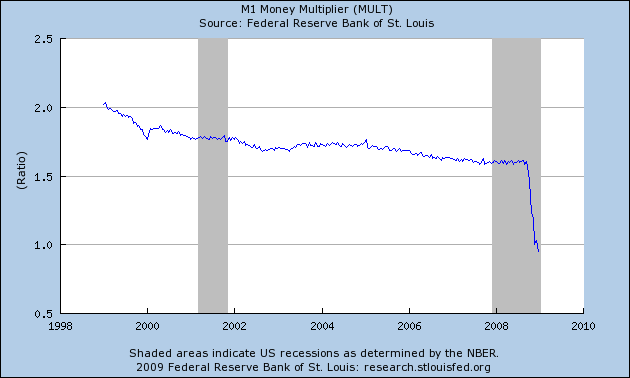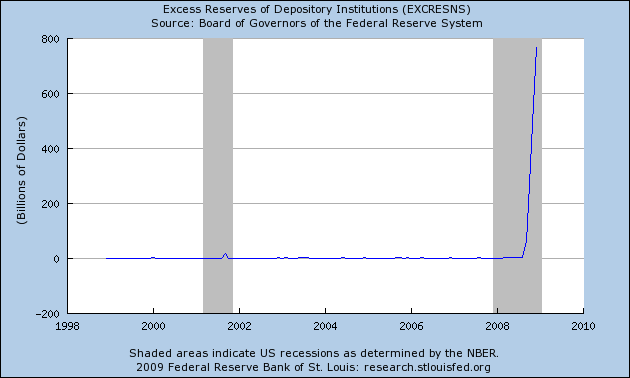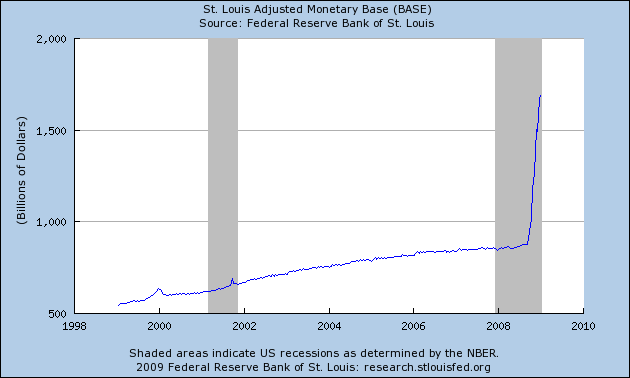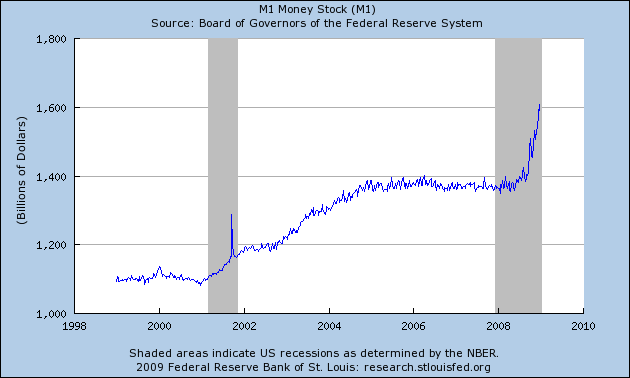Important: Much of this post is mistaken (i.e. wrong). It’s perfectly possible for America to have an M1 money multiplier of less than one even if they were an entirely closed economy. My apologies. I guess that’s what I get for clicking on “Publish” at one in the morning. A more sensible post should be forthcoming soon. I’m leaving this here, with all its mistakes, for the sake of completeness and so that people can compare it to my proper post whenever I get around to it.
Update: You can (finally) see the improved post here. You’ll probably still want to refer back to this one for the graphs.
Via Greg Mankiw, I see that in the USA the M1 money multiplier has just fallen below one:

At the time of writing, the latest figure (for 17 December 2008) was 0.954. That’s fascinating, because it should be impossible. As far as I can tell, it has been made possible by the wonders of financial globalisation and was triggered by a decision the US Federal Reserve made at the start of October 2008. More importantly, it means that America is paying to recapitalise some banks in other countries and while that will help them in the long run, it might be exacerbating the recessions in those countries in the short run.
Money is a strange thing. One might think it would be easy to define (and hence, to count), but there is substantial disagreement of what qualifies as money and every central bank has their own set of definitions. In America the definitions are (loosely):
- M0 (the monetary base) = Physical currency in circulation + reserves held at the Federal Reserve
- M1 = Physical currency in circulation + deposit (e.g. checking) accounts at regular banks
- M2 = M1 + savings accounts
They aren’t entirely correct (e.g. M1 also includes travelers cheques, M2 also includes time/term deposits, etc.), but they’ll do for the moment [you can see a variety of countries’ definitions on Wikipedia].
The M1 Money Multiplier is the ratio of M1 to M0. That is, M1 / M0.
In the normal course of events, regular banks’ reserves at the central bank are only a small fraction of the deposits they hold. The reason is simple: The central bank doesn’t pay interest on reserves, so they’d much rather invest (i.e. lend) the money elsewhere. As a result, they only keep in reserve the minimum that they’re required to by law.
We therefore often think of M1 as being defined as: M1 = M0 + deposits not held in reserve.
You can hopefully see why it should seem impossible for the M1 money multiplier to fall below 1. M1 / M0 = (M0 + non-reserve deposits) / M0 = 1 + (non-reserve deposits / M0). Since the non-reserve deposits are always positive, the ratio should always be greater than one. So why isn’t it?
Step 1 in understanding why is this press release from the Federal Reserve dated 6 October 2008. Effective from 1 October 2008, the Fed started paying interest on both required and excess reserves that regular banks (what the Fed calls “depository institutions”) held with it. The interest payments for required reserves do not matter here, since banks had to keep that money with the Fed anyway. But by also paying interest on excess reserves, the Fed put a floor under the rate of return that banks demanded from their regular investments (i.e. loans).
The interest rate paid on excess returns has been altered a number of times (see the press releases on 22 Oct, 5 Nov and 16 Dec), but the key point is this: Suppose that the Fed will pay x% on excess reserves. That is a risk-free x% available to banks if they want it, while normal investments all involve some degree of risk. US depository institutions suddenly had a direct incentive to back out of any investment that had a risk-adjusted rate of return less than x% and to put the money into reserve instead, and boy did they jump at the chance. Excess reserves have leapt tremendously:

Corresponding, the monetary base (M0) has soared:

If we think of M1 as being M1 = M0 + non-reserve deposits, then we would have expected M1 to increase by similar amounts (a little under US$800 billion). In reality, it’s only risen by US$200 billion or so:

So where have the other US$600 billion come from? Other countries.
Remember that the real definition of M1 is M1 = Physical currency in circulation + deposit accounts. The Federal Reserve, when calculating M1, only looks at deposits in America.
By contrast, the definition of the monetary base is M0 = Physical currency in circulation + reserves held at Federal Reserve. The Fed knows that those reserves came from American depository institutions, but it has no idea where they got it from.
Consider Citibank. It collects deposits from all over the world, but for simplicity, imagine that it only collects them in America and Britain. Citibank-UK will naturally keep a fraction of British deposits in reserve with the Bank of England (the British central bank), but it is free to invest the remainder wherever it likes, including overseas. Since it also has an arm in America that is registered as a depository institution, putting that money in reserve at the Federal Reserve is an option.
That means that, once again, if Citibank-UK can’t get a risk-adjusted rate of return in Britain that is greater than the interest rate the Fed is paying on excess reserves, it will exchange the British pounds for US dollars and put the money in reserve at the Fed. The only difference is that the risk will now involve the possibility of exchange-rate fluctuations.
It’s not just US-based banks with a presence in other countries, though. Any non-American bank that has a branch registered as a depository institution in America (e.g. the British banking giant, HSBC) has the option of changing their money into US dollars and putting them in reserve at the Fed.
So what does all of that mean? I see two implications:
- Large non-American banks that have American subsidiaries are enjoying the free money that the Federal Reserve is handing out. By contrast, smaller non-American banks that do not have American subsidiaries are not able to access the Federal Reserve system and so are forced to find other investments.
- The US$600+ billion of foreign money currently parked in reserve at the Fed had to come out of the countries of origin, meaning that it is no longer there to stimulate their economies. By starting to pay interest on excess reserves, the US Federal Reserve effectively imposed an interest rate increase on other countries.